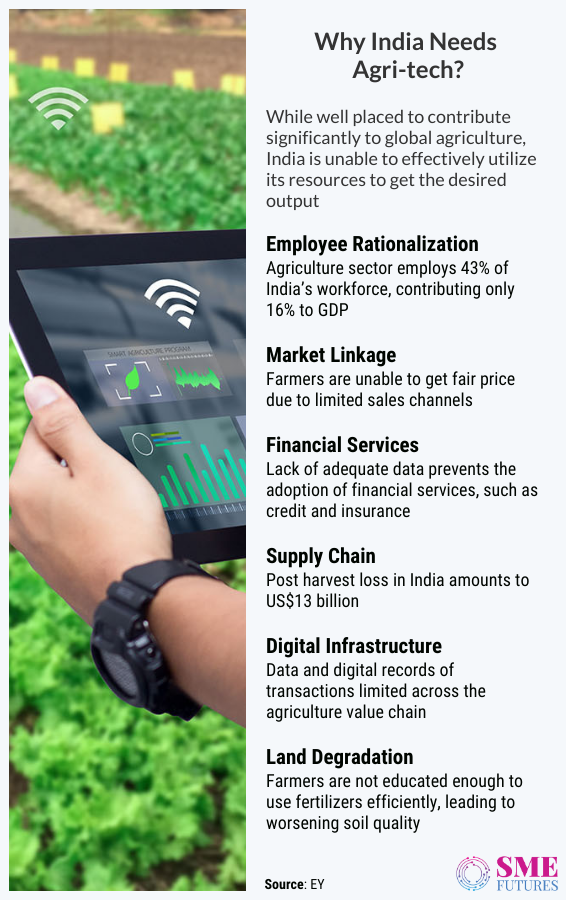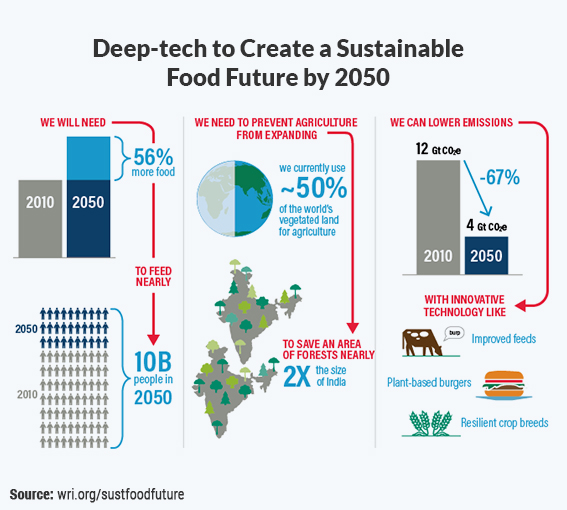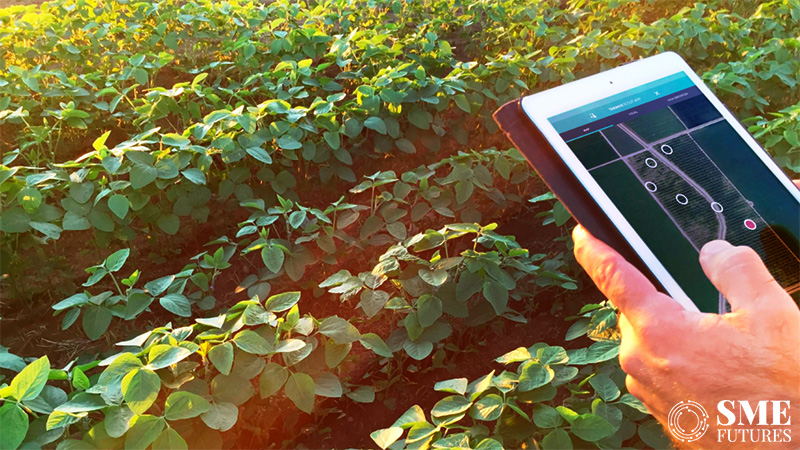India till mid-1960s was dependent on imports to meet food requirement of its populace. Harvest failures, droughts, and famine were very frequent. Green Revolution led India out of era of chronic food shortage and helped our country to usher into food self-sufficiency. Afterwards, India became a food exporter in 1990s.
Today tech-revolution is changing the way India is farming. Mali Narendra, owner of Vadli Farm in Banaskantha district of Gujarat uses app based on satellite imagery to keep tab on what is going in his farm. Similarly, farmers in Khutahan village in Mirzapur recently learned to use drones for planting seeds.
A team of agricultural experts from Banaras Hindu University (BHU) demonstrated the use of drones in fields of rice and wheat. Tractors could not be used for tilling due to wet soil.
The new generation of tech-savvy farmers like them is re-inventing agriculture methods. By adopting new techniques and by analysing data gathered from sensory gadgets present in tractors, farmers can take decisions about the imagery of crops.
“Through the data that is collected through precision farming or deep tech, decisions for agronomic processes on farms can be taken. The right measures taken towards precision farming and deep tech should be made available at affordable costs to these farmers and will help them in improving their productivity and to achieve better profitability,” tells Sanjay Borkar, CEO and Co-founder of FarmERP, an agritech platform for smart agriculture solutions.
This approach is called precision farming or deep-tech agriculture which makes farming more accurate and controlled.
The key component of this is information technology and data that ensures what crops and soil a farmer requires in producing healthy crops. It relies on specialised equipments such as GPS, sensors, soil sampling, telematics, robotics etc.
Though it is not new in India, it is still in early days and catching up.
“Indian farmers are receptive and changing with time. If we can show them the value in the context of their farming services will flow,” says Amit Sinha, co-founder of Unnati Agritech, a Noida based Agritech platform.

Deep tech farming in changing agricultural landscape
Our world is growing faster than the ability of farmers to feed it. The Food and Agriculture Organisation of the United Nations states that there will be nearly 10 billion people on our planet by 2050. With the population growing at this rate, the demand for food is expected to grow exponentially.
Along with this, over 2 billion people globally do not have regular access to hygienic and nutritious food while 1.6 billion tons of food worth about US$1.2 trillion goes to waste annually. It is about one-third of the total amount of food produced globally. These figures depict that world is grappling with a significant shortfall of food produced and what is needed to feed everyone by 2050.
This concerns India too, which is the second most populous country in whole world.
Besides the challenge of food security, the agriculture sector in India is grappling with multifold challenges in its growth. Hence, food security and hunger is not the only reason why we need technological intervention in the agriculture. Despite being one of the largest producers of food grains globally, it falls behind other regions like the US and China in cultivating crops such as cereals by 50 per cent.
A lion-share of India’s farm holdings is around 86 per cent which belongs to small and marginal farmers which have low income and other constraints. The average debt of farming household has risen fivefold in a decade and more than 300,000 Indian farmers have committed suicide since 1995.
Adding to it, gap in value chains and other hurdles often compel farmers to leave the occupation. Even though the sector contributes 16 per cent of GDP and employs 43 per cent of the workforce, the Indian agriculture sector is yet to reach its highest potential. Clearly, shortfalls in meeting the demand of food cannot be bridged by the traditional farming methods unless the agri-community adopts technological solutions on a large scale.
Expressing concern over the issue Rajesh Aggarwal, Managing Director at Insecticides (India) Ltd, an agro-chemical maker says, “Entering the third decade of the new millennium and at a time when India has earned a reputation for its technological prowess, one needs to introspect why India’s agriculture is still stuck in the previous century.”
“The bigger issue is that Indian farmers are dependent on monsoon rain and struggle to fetch the right price for their produce even in the 21st century. Both of these issues can be resolved with the help of technology. With a growing population to feed and a need to improve their own earnings, it is inevitable that farmers in India leverage technology,” he adds further.
To improve the dire situation of agriculture in India, institutes and research centres are working aggressively to innovative technological solutions. As per Tracxn data, India hosts around 735 agritech startups. Startups such as Farm ERP, Unnati, Cropin, Equinox and many more are aiding farmers and agri-businesses with latest and easy-to-use technologies and farm management solutions for assessing nature of soil, weather conditions, and providing aerial-imagery.

Evolution and nurturing of agripreneurs
“Precision agriculture and deep tech are essential for India as a vast majority of the land holders within the agricultural stream are small land holders,” says Borkar as he emphasises on the fact that precision farming is one tool that can transform lives of marginal farmers of modern India.
Some of the aspects of farming need quicker technological support than others. These include weather forecast, climate-resilient seeds, more irrigated land, availability of finance or credit facility, and market link and access.
Right from in-hand use of mobile applications and drones to back-end technologies such as artificial intelligence (AI) and big data can help farmers in measuring soil’s salinity, pH balance, and soil fertility. AI-enabled tools make it possible to generate solution-oriented data indicating weather conditions, type of suitable soil while analytics provided by big data at the back end provide crucial real-time insights such as assessing changes needed for better output.
As per EY estimates precision agriculture and farm management players are helping farmer in improving their yields by up to 30 per cent. Still, there are numerous constraints in it for farmers. Borkar explains, “Often for a small farmer, taking advice from dedicated advisors is expensive. They cannot afford it as their land holding is small.”
Borkar’s firm FarmERP is working effectively towards modernising small hold farmers and aims towards making them independent and more efficient in their agriculture practices. They help in mapping and tracing this entire process, from pre-sowing to harvesting, procurement, and sales to traceability.
Borkar tells us, “We focus on Climate Smart Agriculture. The four important pillars that FarmERP stands for ardently are climate resilience, food safety, food traceability and sustainability which are in accordance with the UN’s Sustainable Development Goals. All these four aspects play a very crucial role for a farmer in getting better value for their produce.”
The company is currently working on latest solutions with computer vision, machine learning, artificial intelligence, and IoT. He adds, “We aim to provide farmers and agribusinesses advisory services which help them in reducing and optimizing the fertilizer usage, agro chemical usage, and water usage. We also provide consumers the right guidance to take decisions to save their crop plantation from hazardous climatic conditions.”
Similarly, Unnati Agritech is also turning simple farmers into agri-preneurs with financial digital tools. Sinha, Co-founder of the startup opines that farmers as a consumers are difficult to convince as they pursue agriculture as a hereditary lifestyle rather than pursuing it as a business.
“Farmers often lack access to tools that would help them in pursuing farming as a business and not as a lifestyle. We at Unnati provide them various services such as farmers bank account, working capital support, support in procuring farm inputs for production, expanding market for farm output, and knowledge for data led scientific farming,” he claims.
Talking about latest solutions and the roadmap of the firm, Sinha informs us that they are working on an app which will aid farmers not only in diagnosing but also in accessing right products to manage their farming better. He says, “It will come out soon. This intelligent platform driving the farmer app diagnostics builds upon the transaction pattern of farmers, soil testing information, satellite imagery, variety of seed sown, and farm practices followed.”
BigHaat, an agri inputs digital marketplace and advisory platform recently introduced a comprehensive agri input stack backed by the robust network of satellites, agronomists, and farmers with an aim to deliver autonomous surveillance and crop care in real time.
Company CEO and Co-founder Sateesh Nakula in a media statement said that this facility lets farmers visit their farm by clicking an image and upload through Crop Doctor. The AI technology then advises best practices with most suitable inputs and offers dynamic assistance in real time to farmers. This unique approach is aimed at automating crop care across India giving farmers a reliable full stack farm management approach.
The solution is expected to provide targeted solutions to farmers enabling them to use 20 to 40 per cent lesser chemicals and 30 to 60 per cent lesser water.
On the other hand, agriculture drones are now getting popular in farming and is changing the entire predictability in the sector. For instance, agri-drones are being used to combat locust swarms in Rajasthan.
The government has stationed drones to carry out spraying of organophosphate chemicals efficiently. “Drones can diffuse pesticides on approximately 2.5-acres in merely 15 minutes. Using drones to combat the locust swarms is an immediate, secure, and practical approach,” tells Aashish Aman, Founder and CEO of Equinox’s Drones.
His firm provides drone powered agri solutions and is now receiving great response than ever. Farmers can use drones for increasing productivity in crop monitoring to planting, livestock management, pesticide spraying, crop stress identification, treatment planning, plant growth monitoring, precision farming, scouting, and much more.
Aman tells us that government has acknowledged the importance of unmanned aerial vehicles (UAVs), machine learning, and artificial intelligence with the introduction of an online platform Digital Sky. Drone startups are using this opportunity to accomplish better technological capacities.
Realising the potential of such cutting-edge technologies, centre is already into numerous projects leveraging the exponential technologies. Aggarwal tells, “Government of India schemes such as Pradhan Mantri Fasal Bima Yojana (PMFBY) has chosen to integrate AI technology to reduce the time to settle claims of farmers and has signed a memorandum of understanding (MoU) with IBM to monitor the agriculture sector.”

Systemic adoption through combined efforts
India’s dual goal is to raise small farmer’s income by 2022 and strengthen the competitiveness of agriculture. It can be possible only if the technology is deployed extensively. In a recently held webinar by FICCI on smart agriculture, Anna Roy, Senior Advisor (DM&A, Industry) at NITI Aayog strongly believes that innovation will transform Indian agriculture and the focus should be on spreading awareness about the potential of such technologies in this sector.
She elaborates, “The real challenge for us is not the development of technology but the deployment of technology on a large scale. We as a nation have to come together for the development and deployment of such deep-techs for the agriculture sector.” In fact, most of the experts are also of same opinion.
“The adoption rate is a windfall since it is still has not reached the level of 100 per cent adoption by small holder farmers. Solutions like precision farming and deep tech are at an evolving stage presently. Some of these are giving accurate results but many of them are still at end stages of researching,” says Borkar.
On the same note, Sinha points out that large format farms are adopting tech solutions at a faster pace. “Precision farming in high value crops has been seeing good traction. Deep tech is still at an early stage and has seen some good results but limited mass scale adoption is yet to appear,” he says. According to him, it is more about the cost.
“A major gap in Indian precision farming has less to do with technology and more to do with affordable solutions which are applicable for mass produced crops. A large number of farmers are involved in producing crops which require low-cost solutions. Hence, solutions should be in accordance with small landholding sizes,” he suggests.
Role of policymakers and corporate owners
Experts are also of opinion that technology adoption is now more significant than ever as we have faced unprecedented times. Last year due to pandemic lockdowns, agriculture suffered significant turmoil. Crops which were ready to harvest were left to rot. Daily field workers were out of the jobs. Movements were restricted which led to revenue loss in this sector too.
Despite obvious benefits of adopting technology, the ground reality is that farmers especially those who are elderly are reluctant. They seek help from young individuals for solving any problem that may involve using an app or searching a solution on the internet. In absence of any such help, they go to credit officers of the bank or to their nearest KVK.
According to Aggarwal, people are unable to assess the value of investing in the cost of a smart-phone since an accidental drop in the field will lead to loss of that amount of money. They do not realise that the availability of any information without someone’s dependence can improve their efficiency manifold.
As academia remains the cradle of innovation, the scaling up of products depends largely on right policies and profitability. He suggests, “The policymakers must devise ways to enable academia in accessing farming lands and conduct their experiments real-time outside ideal conditions of their laboratories.”
“Besides, provisions must be created to enable costly technologies being purchased by the government bodies or panchayats and leased out to farmers. A case in point can be of Pusa Decomposer. It was invented by scientists of Indian Agricultural Research Institute (IARI). A product just out of the laboratory faces a trust barrier. The Delhi Government took the initiative of reaching out to farmers and convinced them to use it under IARI scientists,” he adds.
One factor that most of the industry experts bring out is that India lags behind in agriculture due to less adoption of technological tools. This is the primary reason behind marginal or small status of most of the farmers. Sinha on this says that India lags in productivity of agricultural yield across few crops as it has small farms.
“Specific solutions built on deep tech platforms would change India’s landscape for agriculture. The precision farming concept was difficult for adoption in India earlier because majority of the farm holding was small in India. Hence, it wasn’t commercially viable from the perspective of both supply and demand,” he claims.
Despite this, India’s burgeoning start-up ecosystem has played an active part in disrupting the agriculture sector. Agritech start-ups are operating in an attractive market with an estimated potential of US$24b by 2025. Lately, the funding scenario has also accelerated. Venture capitalist and investors have been responding very well. According to the statistics of Maple Capital Advisors, agritech firms have clocked $84 million as against $153 million during the same period in the first half of 2020.
It has also forecasted investments to exceed US$ 500 million in next two years. On this Sinha comments, “There is a lot of interest in Agritech sector with significant number of people being funded. The number of companies and the quantum of funding both have gone up significantly.”
Going ahead, recent policy reform announcements are expected to add a fillip to the sector by encouraging private investments. This certainly will help government in achieving the aim of doubling income of farmers by 2022. Due to these steps, India’s agriculture sector in the next decade will no longer rely on conventional methods. Instead, it will adopt agriculture 4.0 to push country’s economy to its full potential.











